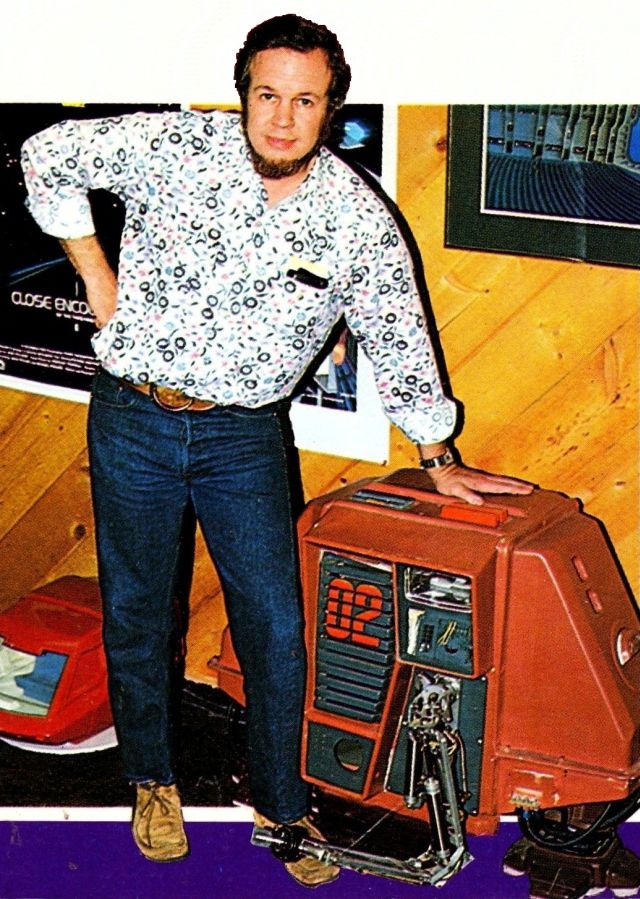
Douglas Trumbull with Drone #02, "Huey", in his personal collection at the time. [Starlog]

Doug Trumbull talking to the actors inside the Drone suits.

Poor quality picture of Doug Turnbull with "Huey" in his office. [Source: The Victoria Advocate, 4 Aug 1977]
Early Concept Drawings
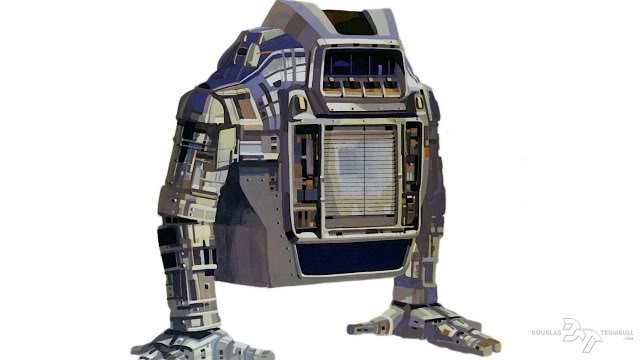
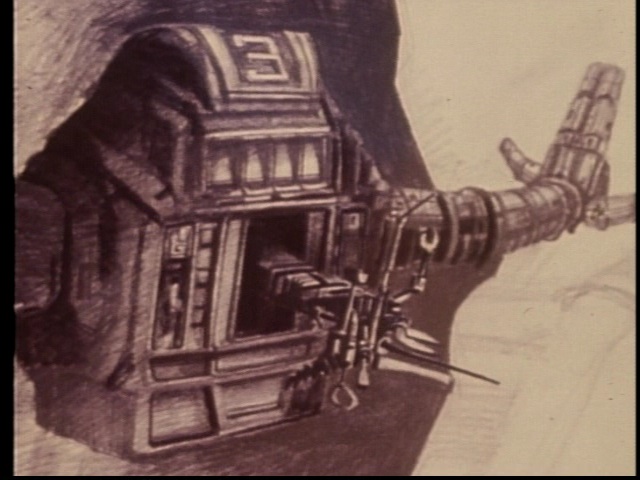
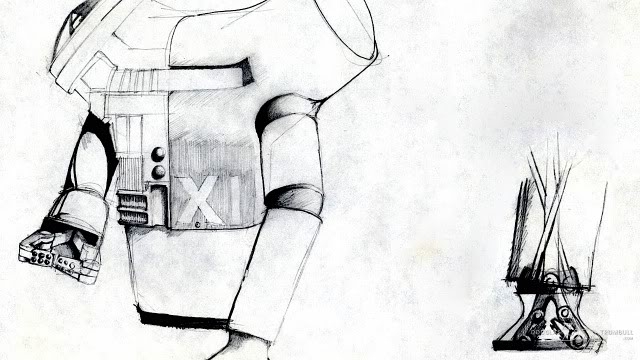


Drone Concept drawings.
The credited people behing the Drones are Doug Trumbull, his father Don Trumbull who at least built the arms, Paul Kraus & James Dow.
In an interview on the construction of "Phil", the robot from Heartbeeps, "Phil"'s creator was Jamie Shourt, who says he was also involved in the creation of the Drones. Shourt was a business partner of Trumbull's earlier on, so there may be some truth to the statement.
The Amputee Actors
[I derived which actor was inside each Drone by the images below.]
Drone #01 [Dewey} (Grey) was manned by Mark Persons.
Drone #02 [Huey] (Orange) had 2 different actors/amputees at different times. Most likely distinguished by the slightly different bases employed by each. Steve Brown was first and had a narrowed base most of the time. Chery Spark's has a stepped protrusion. Both were long cases when compared to the others. It appears as if Cheryl replaced Steve sometime through the filming.
Drone #03 [Louie] was manned by Larry Whisenhunt, aged 16.
Most of the time, the robot arm was a dummy, to save weight. This is most evident when the forearm is almost flush with the drone's body.
Interview with Doug Trumbull by Castle of Frankenstein magazine (Issue #19)
T….As everyone said, the only human on board Discovery was HAL. I didn't see it that way at all. Futurity does not necessarily denote inhumanity. The character that Bruce Dern plays is warm, funny, and fallable. I decided to work with that human element.
CoF: The Drones contribute to that warmth.
T: It's curious about the drones. If you were to see the film again, you'd see that most of the humanity of those machines is a result of your own projection. They're programmed metal; if you need a companion, you simply punch a button. If you need a surgeon, you change its function—very simple.
CoF: But there's obviously a great
amount of emphasis on the drones to humanize them.
T: Part of SR's theme is the relationship between Dern and his drones. It's not 2001 — machinery isn't malevolent. They're simply tools. Look, here you have this guy who's a murderer. He's killed three of his friends. He's alone on a vessel that's as isolated from the rest of the population as possible. He begins to crack, to feel his conscience. So he creates companions by reprogramming the drones. An interesting thing.
CoF: There was a photo article in
Esquire…
T: Yes. It was a very cruel thing. Cold. We tried to stop it. Tried to stop them printing it. So, we used amputees. So what? They're people. That's a horrible cliche, but it's true. They're human beings.
CoF: How did you get the idea for using amputees for the drones?
T: When I was in London, working on 2001, I saw a film called FREAKS. Have any of you seen it? Well, there's one little fellow; he's very handsome, and neat — he's dressed in a tuxedo and a bow tie. Only, from the waist down, he isn't there. So, here's this remarkable, beautiful guy, with this amazing agility,
leaping and running on his hands through the room, jumping up on chairs, etc. And not once did you feel horrified. You're amazed and respectful at his adjustment. That impression stayed with me when it came time to cast the drones. I knew what I wanted.
CoF: Wasn't there any resistance to the idea of using these people?
T: Only from the studio. Producers are the most unpleasant groups of humans on the earth. They said we could use midgets, or children, but not amputees — we had to fight very hard for that. And it worked.
CoF: You say "kids." How old were they?
T: Fifteen to twenty-two. Four of them worked with us. One was a girl, one was a black kid from Watts who leaped off a moving train. The others were congenitally handicapped. This was, literally, the only job these people could get.
CoF: How did they like the work?
T: They loved it. They all made a lot of money and spent it like crazy.
CoF: For non-professionals, they certainly did a fantastic job.
T: Yes. They were a great help.
Speaking of ideas, and things just happening — do you remember the bit when Huey is outside the ship, waiting for Bruce to give orders? If you look closely, you'll see he's tapping his foot.
Between takes in the filming of SILENT RUNNING, the "secret" of the Drones locomotion is revealed as Cheryl Sparks, one of the amputees, has a chat with Bruce Dern.
That was a spontaneous thing. He, the actor, was bored, so he tapped. We filmed it.
CoF: When Dern comes into the rec' room, two of the drones are waiting. One drone has his back to the door. Drone facing Dern taps drone facing away on shoulder. Drone turns. Was that bit in the script?
T: It all comes back to what we were saying about things just happening. These guys were cooped up in six-inch thick plastic suits. They could barely see. The only way they could communicate was by yelling and banging each other on the shoulder. One day I saw them doing this on the set, and I thought, "Great !", and we put it in.
CoF: …(more interview, but not about the drones)……..
Steve Portigal has put up the Esquire (Sept 1971) pages as mentioned above. They are copied here for convenience.
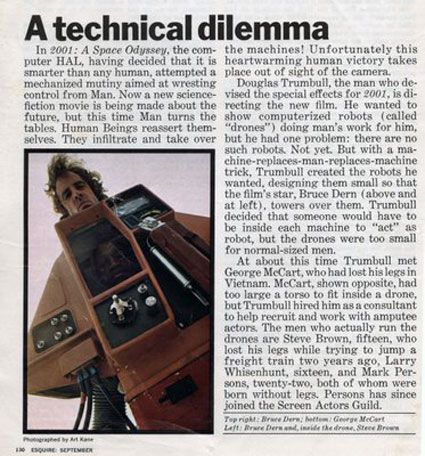
Above: Bruce Dern with Steve Brown inside Drone #02.
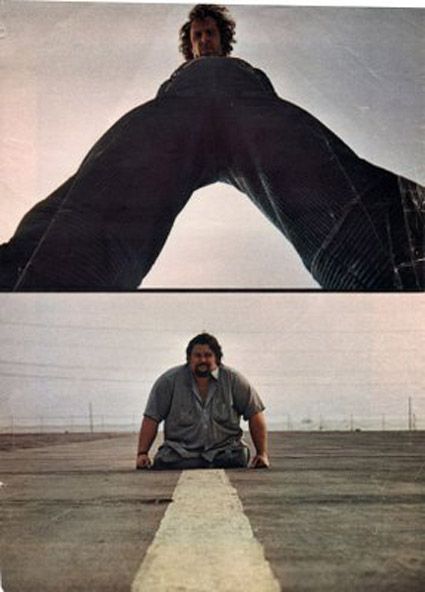
Above: Top-Bruce Dern looking down. Below – George McCart.
The white line runs down the deck of the then de-commissioned aircraft carrier "Valley Forge".
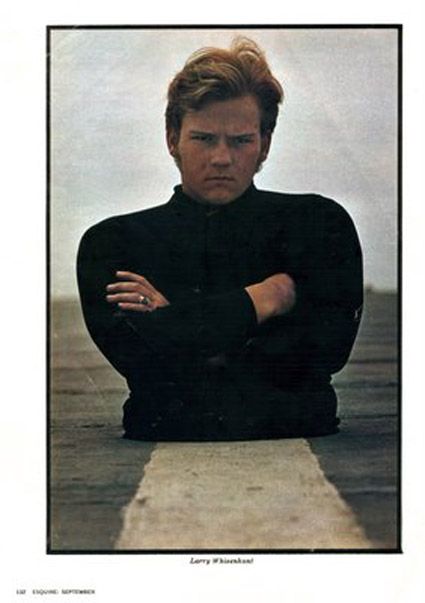
Above: Larry Whisenhunt
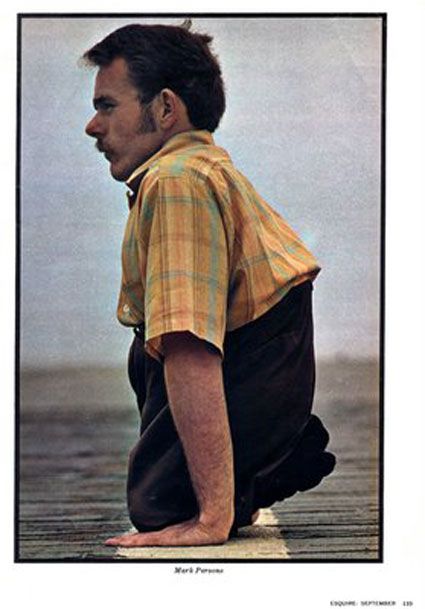
Above, Mark Persons
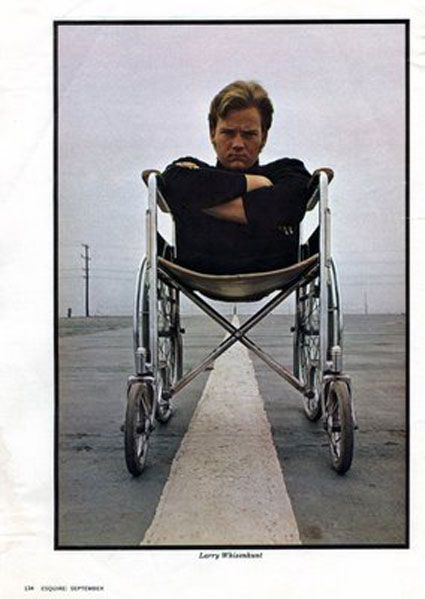
Larry in wheelchair.

Various screen grabs of the amputees inside their drone suits from "The Making of Silent Running".
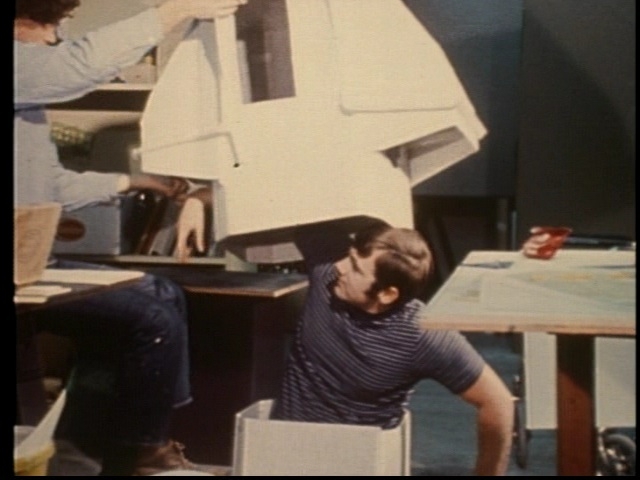
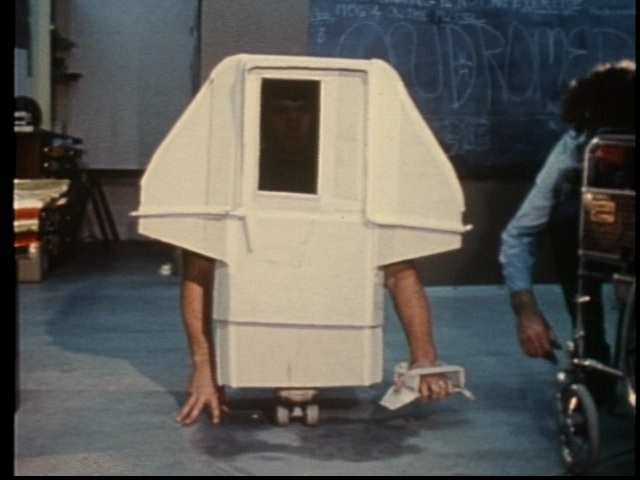

Steve Brown as Drone #02 Huey – arm is a dummy for this scene.

Cheryl Sparks as Drone #02 Huey – arm is a dummy for this scene also.
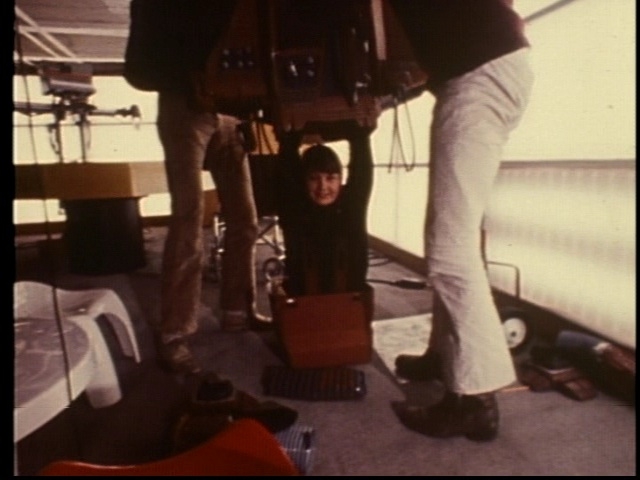

[ Source: the above images from Powet.TV and MiriorDArc, but are actually grabs from "The Making of 'Silent Running'"]
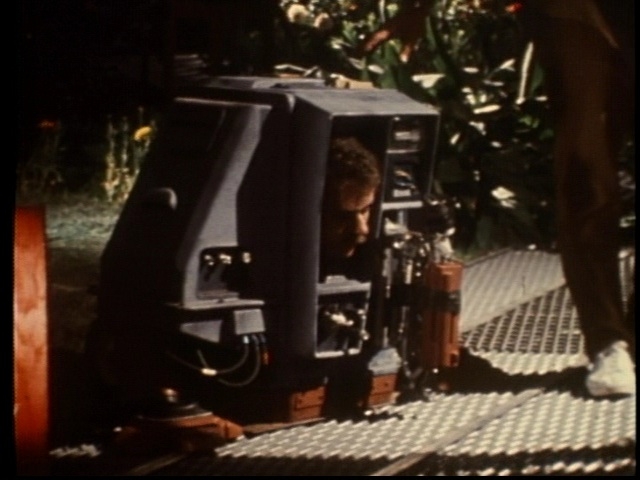
Mark Persons inside Drone #1 [Dewey]. A real robotics arm, not a dummy, is attached in this shot.
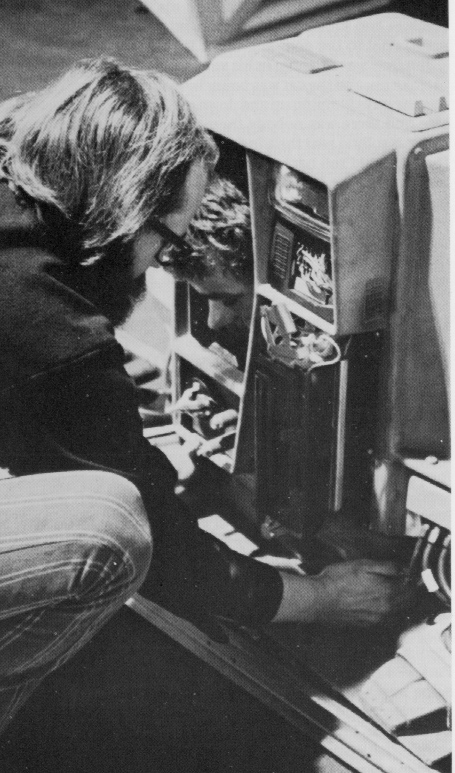

Some images thanks to David Buckley for locating them, and to Vince Backeberg and Mark Dowman.
Other images of Drone actors.
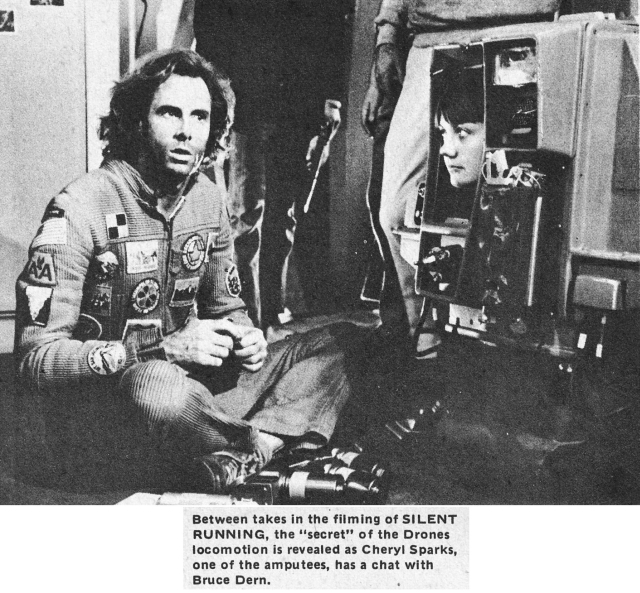
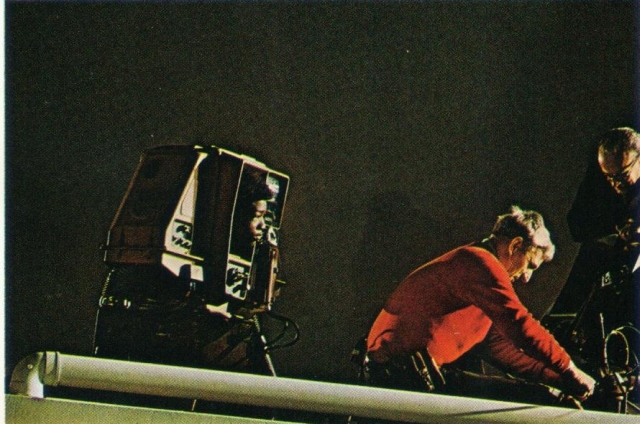
Steve Brown in Drone #02 suit.
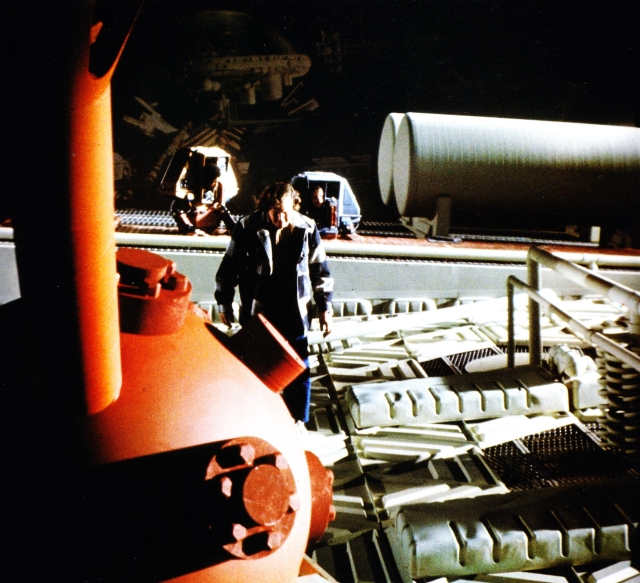
Trumbull with drones on set.
Drone Arm and Grippers
The end effectors are interchangeable. As the Drones are service robots, they are supposed to be capable of doing many things with their one arm.

I notice on this wonderful 2004 drawing by Eric Kristiansen that what I believe to be tools in tool bays, he calls them 'sensors' or 'sensor arrays' .
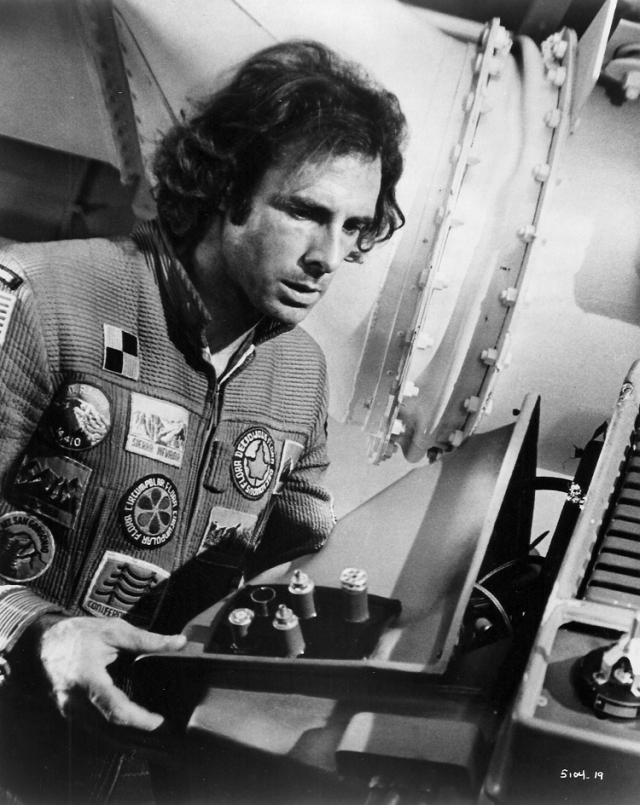
Most of these additional tools [assuming they actually are tools] appear to be dummies. The real gripper in the tool bay is most evident in this still.
The Drone arms were designed and built by Don Trumbull, Doug Trumbull's father, who had a history in Special Effects, starting with "The Wizard of Oz" (1939) .
In reality there appears to be only 1 interchangeable end-effector that is carried by the drones, and that is the most common one seen here. The general-purpose robot gripper has a pincer action with flats on each finger. When it is not located in the arm, it is in its recepticle in the tool bay on the front of the body [in reality, the pneumatic lines to the gripper prevent disengagement of the gripper to the wrist/arm].

Here's a series of images [below] that shows Drone #02 hooking up its wrist connector to the gripper. The geometry of the arm and the location of the end-effector would have limits where connection to tools/end-effectors could occur.
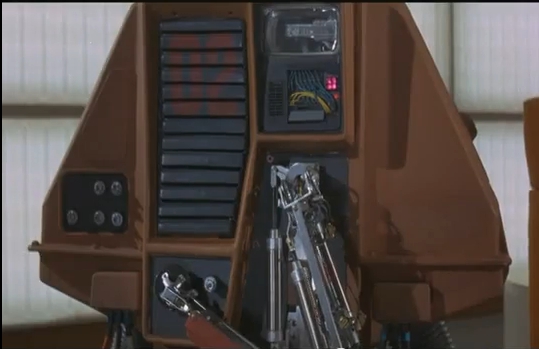
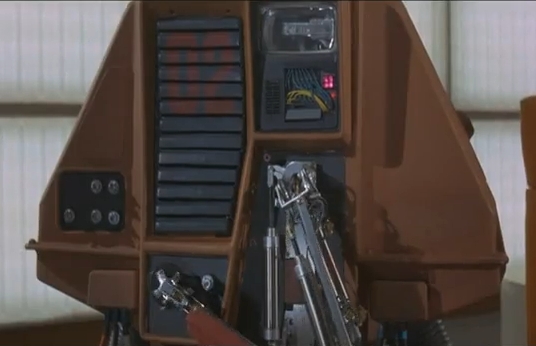

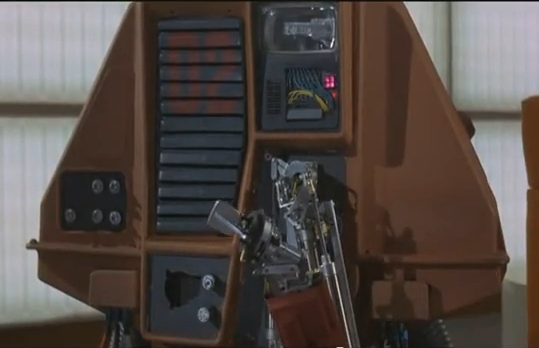
The 4-quadrant pink light is, in my opinion, the Drone's "eye". Most noticeable during the game of poker when "Huey" look's at his own cards and the lights turn on and off.
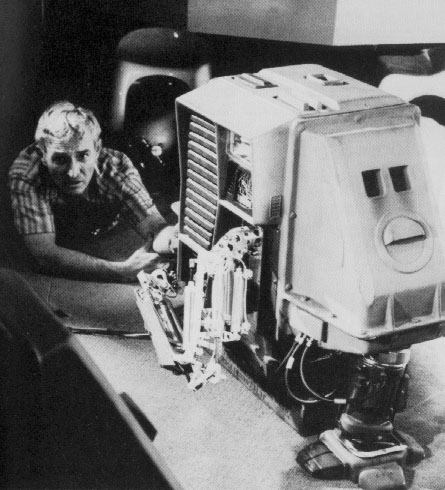
A black and white pic showing the arm just after it hooked up the gripper to its wrist connector from its home in the tool bay.
The other interchangeable end-effectors (or tools, as the case may be) seen in action include long-tanged fingers, hooked (or clawed) fingers, rotary high-speed saw, welding electrodes, and possibly a screw-driver or a probe of some sort.

Long-nosed fingers holding bandage roll.
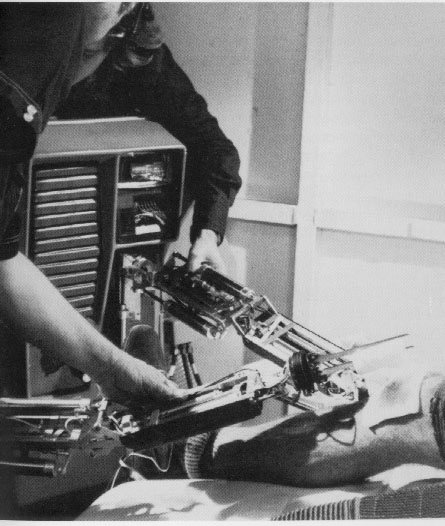
For the operation, the arms were manipulated by off-camera crew, including Doug Trumbull himself.
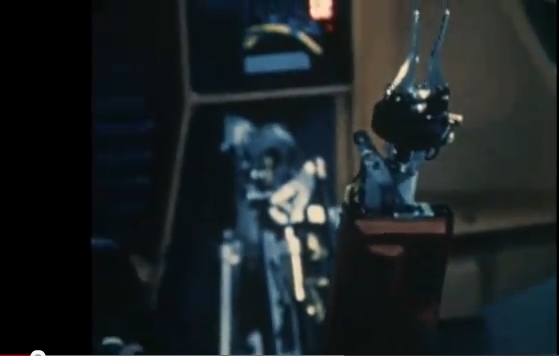
Medium-nosed gripper fingers.

Hooked-fingers suitable for grasping scissors.
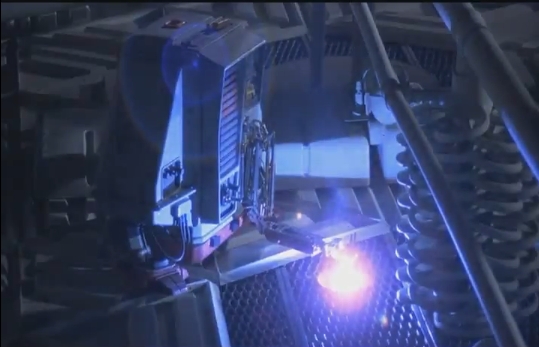
Arc-welding attachment.
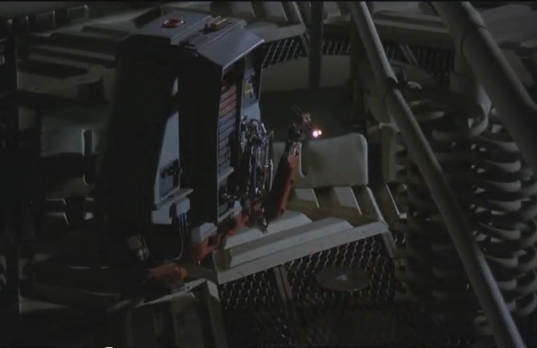
After-glow of welding attachment..
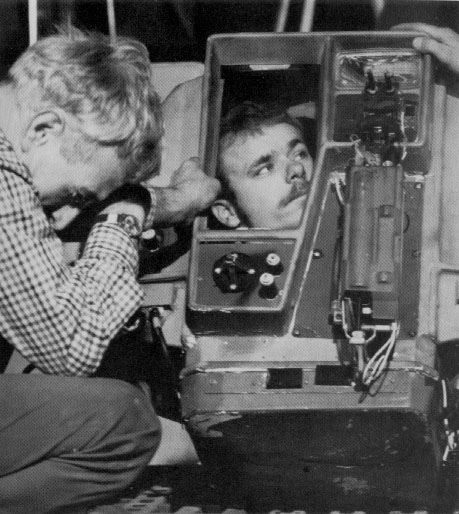
Close-up of arc-welding attachment. Notice general-purpose gripper in tool bay.

Colour close-up of welding attachment.
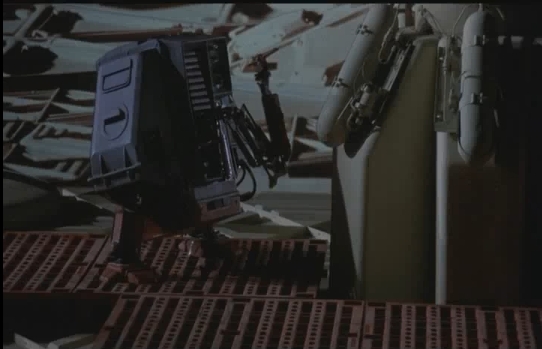
Probe or screw driver. Interesting to note that this tool is held by the gripper, but there is another (standard) gripper already in the tool bay. A small continuity error.
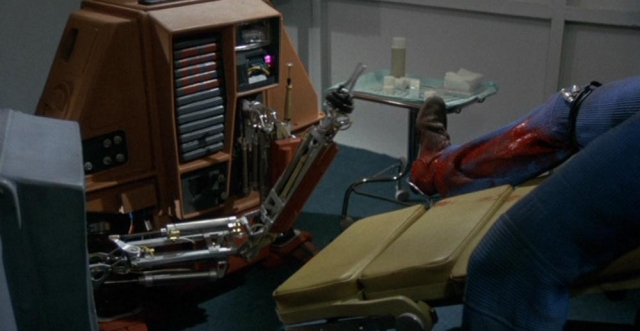
High-speed cutting tool (not grasped by gripper) and long fingered gripper ready for the 'operation'.

Another view of the high-speed rotary cutting tool directly inserted into the wrist adapter. I don't believe it would have been operational in this shot, as these tools are air powered [brand of air-tool not yet identified].
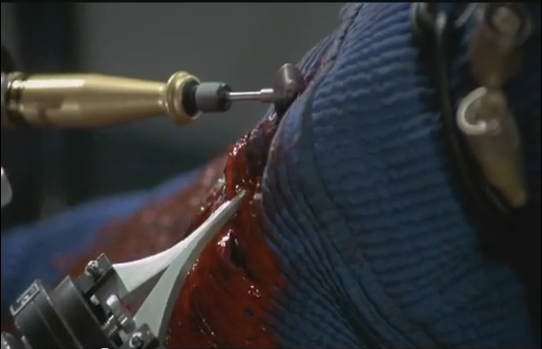
As revealed in "The Making of …", Dern was worried that a remotely controlled arm, if a mistake was made, would "cut off his leg". A bit of an overstatement, but nevertheless, a dummy leg was made up, and Doug himself manouvred the arm (off-camera and seen in b/w image above) by holding it with his own hands to cut the pants.
Selectred transcript from "The Making of 'Silent Running'"
Narrator: Scott Beach
DT and one of the most important things that I had as an idea was the idea of doing the drones.
Narr: The Drones – In the story their job is to relieve humans of boring routine maintenance on the spaceship. In science fiction, robots have often been the bad guys Molevolent semi-human contraptions sneakily computing ways to take over. But Doug Trumbull wanted to show that these man-made devices are only what the're made and absolutely under human control.DT: The idea was to find a human being that you could deal with as an actor but their wouldn't be necessarily shaped like a human being. Why just put a big plastic or rubber suit over a man and say that's a robot? Do something that defies an audiences capability to understand how it was done. We wanted to be totally be non-Anthropomorphic in appearance. No face, no eyes, nothing that is glaring out, nothing that's necessarily symetrical like a human being. The working robot models that we use in the picture are the prototypes. in that we did a lot of drawings, a lot of visualisations of what we wanted But when on paper we got to a point where the shape was right if we could see that the shape was going to work the way we wanted we just started making moulds out of wood and vacuum forming styrene plastic over the wooden moulds and fitting them together and making the design in such a way that it could be altered to fit each individual person inside.
Narr:
Larry Whisenhunt, aged 16
Steve Brown 15
Mark Persons 22
Cheryl Sparks 17. All double amputees, all very talented.Another narrator: What's it like inside that suit?
CS: Well, Its quite comfortable and everything. It's awkward when you're trying to walk and stuff.
Narr: Is there a special feeling that you have towards people once you're inside that outfit – you start taking on a feeling of a robot.
CS: You do kinda, yeah
Especially the scene when the dome? is about to blow-up It's like I was really there and in a few seconds everything was really going to blow-up.Narr: What do you like to do? What are your activities?
CS: Horseback riding, swimming, surfing, water skiing, any outdoor sports. And fishing.
Narr: It took several technicians to build the drone models
Narr: This is Paul Kraus
PK Well, Of course, the first problem was trying to find people that would fit in them . After that just measuring, getting an awful lot of human Dimensions then after that the main problem was material. Because the biggest structural problem that we found was that they had to be lightweight. We had to keep them under 20 lbs, which we did, they run out just under 20lbs.
[Bruce Dern talking on set for a bit.].
Narr: The Drones are programmed to do their job with little or no human attention, but in the poker sequence is was man-to-machine. Bruce Derm played the part of Freeman Lowell. He programmed the drones to play cards.
[Richie was operating Drone #02’s arm in this scene]
BD: One of the keys to the film is the fact that are that they are not mechanical. The fact that here's a guy all by himself. He's looking at a box…… has no eyes, no mouth, no ears and yet it's alive, and there's something that I respond to as an actor, as a human being, and as a character in the film and that's what's its really all about. Somehow the fact that any little box or machine I've always been scared of machines anyway, that can move around the floor and stuff. I saw a movie once, "The Glass-Bottomed Boat", it was terrible movie but Rod Taylor and it had a little machine that cleaned up his kitchen, you know, that he pressed a button it came… [new part 2 from Youtube missing transition]
…packing everything there and it scared the shit out of me, man. But I respected it, you know and I thought, that, well, he should talk to it, you know.
[card playing scene].
no more on drones until…
The Making of Silent Running Pt3
8:07
There was a constant problem with the manipulator arms on the drones. They kept not working. The crew tried just about everything imaginable. [The] radio control worked fine in the workshop, but on the ship the metal bulkheads caused interference, and the system wasn't reliable.
Then they tried this sort of pneumatic system. Nothing. Finally they came up with a mechanical system that did just well enough so that the shooting could go on.Doug T-"for everone of those shots there was just numerable takes… constant re-shooting to get the arm to hit the right position.. constantly had to do cutting, and cutting, and cutting, because you couldn't get the arm to do a complex motion and really do anything in any single one take.
A lot of those close up shots of the manipulator arm working when the arm is cutting away the pant leg on Bruce's leg I'd get in there and work the thing myself because I wanted it to cut a certain way, but Bruce absolutely wouldn't be in the suit.
BD: The only time I was really scared was they have that little whirring cutter on that one drone. but it worked of a pump so that when the air is shot through there [whirring noise]like that and it starts going cutting on my pant leg on my thing there there and if it ever slipped it would've cut my leg right off, you know.
Narr: talks about prosthetic leg.
[Please contact me for corrections to the above transcript]
After quite a bit of research I managed to determine whether or not the grippers were custom built or commercially made. Having a manufacturing plate on the side of the gripper was a give-away, but unfortunately I was unable to read the plate. A bit of good fortune in that whilst researching my next post (on Joshua from "Demon Seed") I recalled a 1981 advert that had a similar gripper. I'm 99% sure the Drone grippers and this gripper are the same, pending variances in the fingers. The grippers are B.A.S.E.(TM) Robotic 2-fingered grippers manufactured by MACK Corporation, Flagstaff, IL, USA. They are still in business and the grippers still feature in their pdf catalogs here and here.
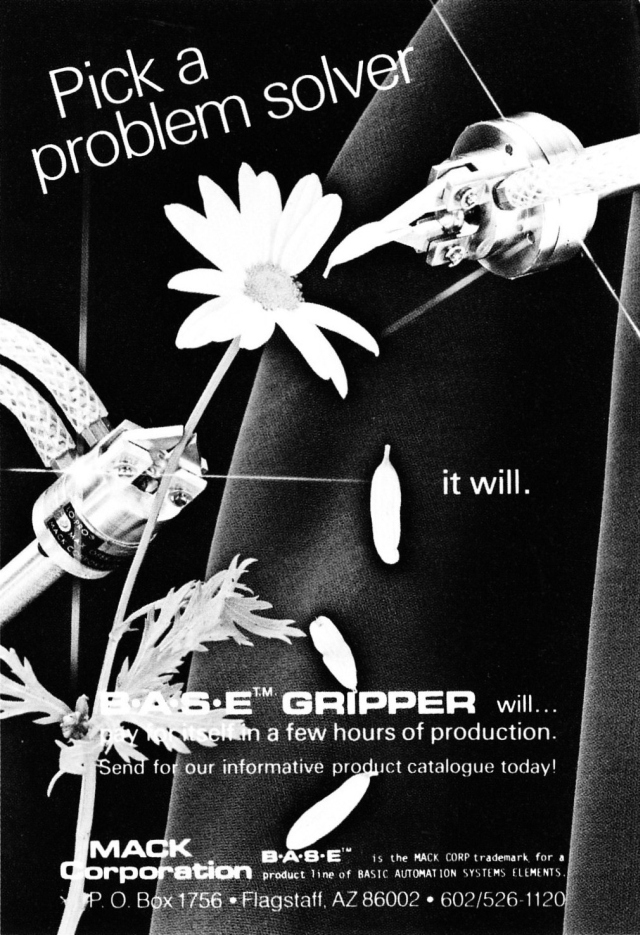
The pneumatic rams were manufactured by Bimba Manufacturing Company, Monee, AZ, USA. They are stainless steel and have brass air-hose fittings.
As at August 2012 one of the arms is for sale by The Prop Store. See a set of wonderful photos ideal for the replica maker. Below is only one of them.

Side view with scale.

Art Andrews put up a high-res picture of the Pneumatic Drone arm as seen at the Prop Store booth at San Diego Comic-Con 2012 here. The display card suggests it was the only operational arm used in the film. When one sees the movie this is clearly not the case. At least 2 arms are seen, particularly the surgery and tree planting scenes [see below].



Side-view showing mounting of arm to body.
Other commercial Parts used on the Drones
In another post on the web, we get informed that the headlight is branded "CARELLO" , and the original part number is 06.390.816. The dimensions of the light are 5-1/2" x 2-7/8".
A possible inspiration for the Drone arms – the Case orthotic arm.
Other than home-builts, no production robots were anthropomorphic, certainly not the industrial robots of the time. However, there were a few orthotics and prosthetics being computerised at the time. One of the very first is the Case arm, developed at Case Institute of Technology c1965. It's been difficult to find a good picture of this arm, but in this poor picture here you can see the similarities between it and the Drone arm. Being anthropomorphic, it has a shoulder, elbow, and wrist, offering 5 degrees-of-freedom. The Case arm is also pneumatic, and has padding around the cylinders which has a resemblance to the red-plastic arm covers on the Drones.
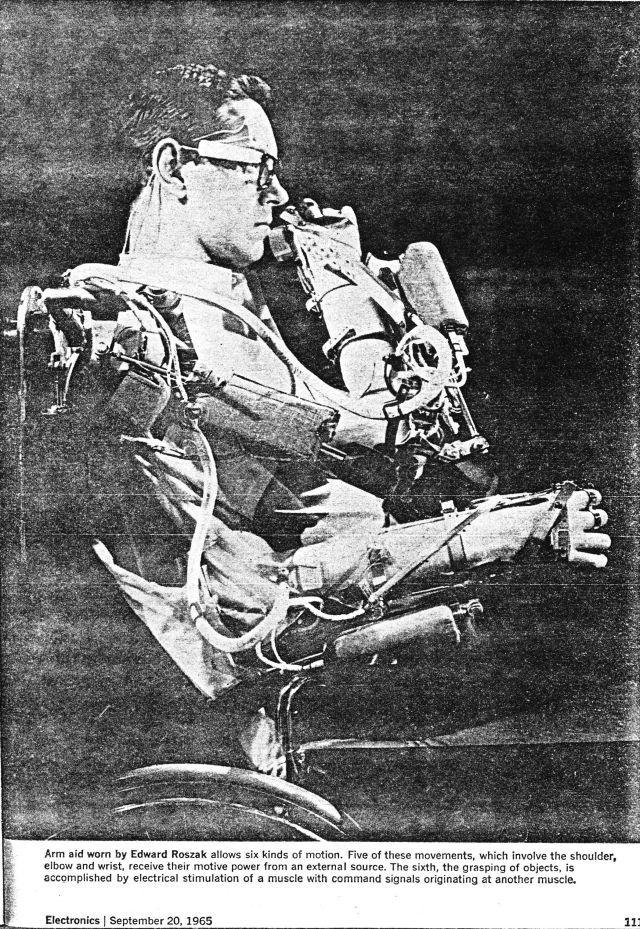

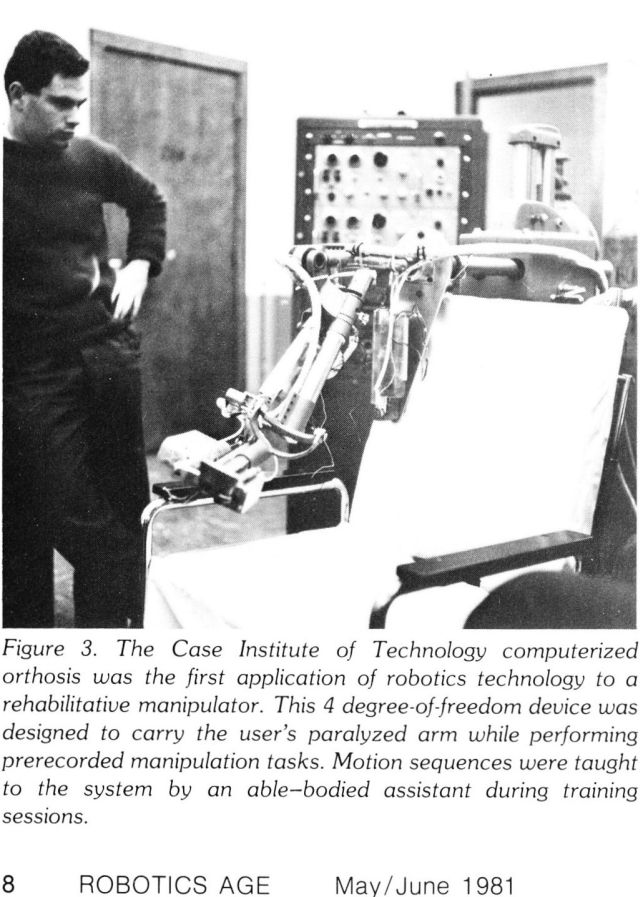
VERSATRAN – The other Robot in "Silent Running"

The "billiard's" playing robot is actually an AMF Versatran industrial robot.

Regarding "Silent Running", for a 1972 movie, the Versatran was still considered a state-of-the-art industrial robot.
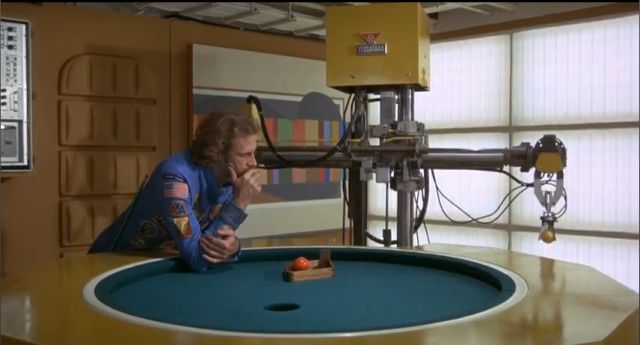
Two interchangeable end-effectors are shown, a gripper for loading/depositing billiard balls, and a pneumatic "cue" to strike the ball (below). The standard two-fingered Versatran gripper picks up a B.A.S.E.(tm) 3-fingered gripped to deposit the balls. Another small continuity error in that when picking up the B.A.S.E.(tm) gripper, the 2 pneumatic lines are not attached, but then magically appear in the next shot (see above). Also in the above image is the AMF Versatran name/logo, as well as the controller on the left.

The control panel in the background is a real and actual point-to-point Versatran control panel, used to program the various movie sequences. Although portrayed as "thinking for itself" , this robot would have to be choreographed and programmed via the point-to-point controller.

See separate Versatran post here.
Related Trivia: Doug Trumbull later designed and patented a remote-controlled character called “PAL” which was first used in the Showscan film LET’S GO for the Toshiba Pavilion at Expo ’85 in Tsukuba, Japan. Closer robotic performance was achieved via a high-tech version of Japanese Bunraku puppetry, performed from below by master puppeteer Bruce Schwartz. PAL was the inspiration for Johnny 5 in the movie "Short Circuit" (1986).
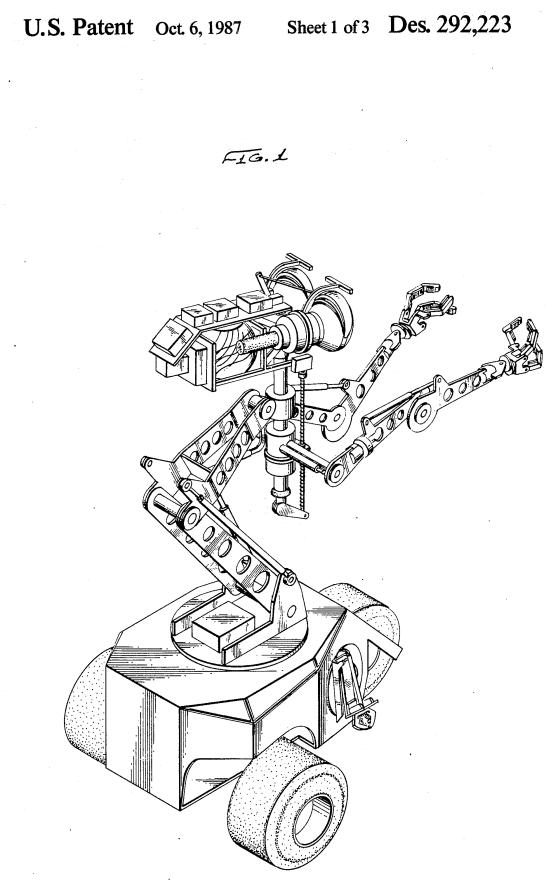
The Robot Controller was first used as a prop in the Showscan film LET’S GO (Live Action, 19:00 minutes) a story of a very special friendship that develops between a boy and a robot, for the Toshiba Pavilion at Expo ’85 in Tsukuba, Japan. As stated by Trumbull, "this gizmo may have interesting future applications as a human-computer interface."
Eric Allard was a young effects wizard who made the robot. The robot effects were achieved with a rod puppetry techniques. For those who don't recognise the name, Eric Allard also built Johnny 5 for the movie "Short Circuit." The appearances between the two are remarkably similar.
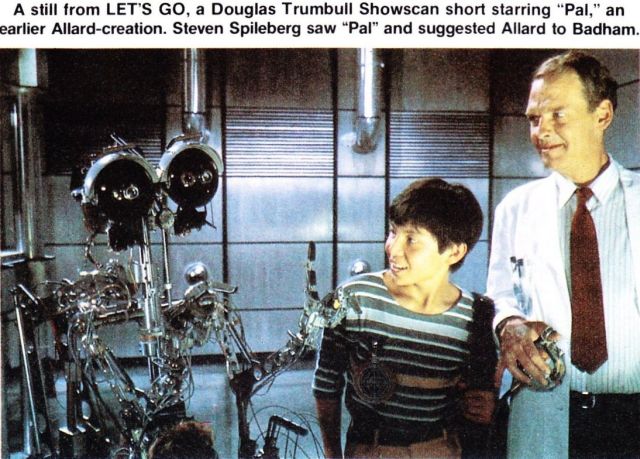
PAL also did a stint on The Wizard as H.E.N.R.I. VIII with David Rappaport. See fansite here.
See separate web entry here.
"Silent Running's" drones inspired "Star Wars" R2-D2
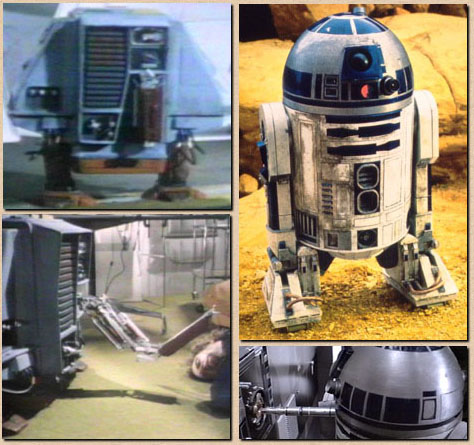
According to a August 14, 1981 Hollywood Reporter article, Universal sued Twentieth Century-Fox, claiming that the droid "R2-D2" in Star Wars was an infringement upon the design of drones Huey, Dewey and Louie. Judge Irving Hill of the U.S. District Court in Los Angeles dismissed the case before trial, however, stating that "no one has a monopoly on the use of robots in art," and that the robots in question were not similar. Universal appealed the decision, but the Court of Appeals also dismissed the case.
Interesting to note that 3-CPO was based on Maria the robot from Fritz Lang's 1927 movie Metropolis, and that Don Trumbull worked on "Star Wars" and was also one of the designers of the Drones. There are certainly a lot of similarities, in terms of size, noises instead of voice, and a utilitarian function between the two. Did Don influence the design of R2-D2?
Los Angeles Times – Dec 5, 1977
……….The drones. by the way, proved to be director George Lucas' inspiration for his own stubby robot, R2-D2, a fact that he admitted to [Doug] Trumbull when he approached him about contributing to "Star Wars." Trumbull, however, turned down the assignment because he did not want to repeat himself by returning to another space opera…………..
Found on the internet is the original concept behind "Silent Running". See here[server now gone Aug 2015]
Another unsung trivia nugget unearthed by greg moss.
This week I’d like to reveal a little-known piece of trivia to do with one of my favourite films of all time – Douglas Trumbull’s 1972 SF eco-fable Silent Running.
This film had a massive impact on me as a third grader and no doubt planted the seed for my lifelong appreciation for ecology. The film screened as a midday movie on television and my favourite teacher Mr. Till (who, looking back, could probably be referred to as a bit of a hippy) sat the class down to watch it. I don’t know about the rest of the kids, but for me, it was a seminal experience.
And one which I will be eternally grateful for.
It was only later, in high school, that I learnt the ecological aspects which had such an impact on me weren’t actually present in Trumbull’s original story idea which was primarily about the relationship between the Lowell character and the drones.
The shooting script was ultimately credited to Deric Washburn & Steve Bochco and Mike Cimino (who subsequently directed The Deer Hunter).
In an interview with Trumbull, published in the August 1978 edition of Fantastic Films magazine, Trumbull outlined his original story …
“I wanted to elaborate the story of that relationship [between Lowell and the drones] showing how the machines changed from simply doing their job to their anthropomorphization into real characters. I wanted to show what a dead end it is but also what a wonderful thing it is because of the output of emotion.”
“Around the beginning of 1970 I met [producer] Mike Gruskoff. He said “Come up with a story and maybe I can sell it for you”. I worked out a short story and we made a deal with Universal Pictures”.
“That story involved contact with with an extraterrestrial life force. It was the basic story of some ET’s who are travelling around and who detect this guy who is totally alone, totally isolated. He’d be the guy to make contact with. Here’s a guy out alone. He likes being alone. He likes that job. He’s totally alone in the ship with his little robots whom he has no relationship with at all. He’s getting a little bit old for the space program and he gets the kiss off from the company. They say “You’re being retired with congratulations and everything … and we’re really glad you’ve done such a good job for us.” He says, “But I don’t want to go back. I like it out here alone. I don’t want to go back to Earth. I just want to be left alone.” Here he is with a big old clunky space freighter that is going to be decommissioned anyway. It’s a big piece of shit and he says, “Well, I’ve always sort of wanted to go out exploring.” He decides to steal the ship and he enlists the help of the drones. He reprograms them to help him out and respond to him. They tear out all the communications equipment, throw it out into space, paint the whole ship totally black so no one can see it jet off. He’s constantly threatened by the fact that he could be pursued, that the authorities will be out looking for him. He’s a space pirate, and he’s having the time of his life. He sees a little blip on the radar screen which is the only thing he’s kept functioning. He sees something approaching his ship, and figuring the only safe way is to stay out of sight, he goes into the silent running mode. He turns off all the lights, all the electricity, anything that emits any kind of detectable emission. The ship’s all black and everything. He tries to be absolutely cool and not make a noise and not do anything. No light, all black. And he just waits and this blip gets closer over a period of a week he’s sitting there watching it and he’s sort of cracking up, watching this radar scanner. The air is getting really foul and the oxygen is getting really thin because he hasn’t got the air conditioning on, and finally just before it gets there he passes out. Then there’s this really neat sequence that happens.
It’s all seen from just his room. He’s in the control room. He’s all alone, completely conked out. He’s in that room and it’s dark and you just hear this big clunk of two ships coming together. Then you hear the air lock open and footsteps going down the hallway. You hear things going by. You hear someone turning the knob of the door. It’s all dark. And the camera is just cruising around. By this time with all the things turned off the ship’s in weightless condition. There are books and junk floating through the room and you just sort of see shadows moving. You go back out and the door shuts and the electricity comes back on, and he wakes up a few minutes later with fresh air and everything. The ET’s are gone. He looks around and finds all the places where they pried doors open. He sees all the manifestations that some weird being was on his ship and had saved him by turning the oxygen and stuff back on for him. Finally he realizes that one of the drones is gone. The drones are constantly transmitting television pictures to the three little screens in the control room. He figures that by setting up a little impromtu tracking system he can find out where the drone’s signal is coming from. He sets up his antenna and gets this little, weak signal. He tunes it all in and he’s super adjusting it, increasing the gain and everything, and finally he gets a picture from the drone and it’s a view of our own galaxy receding away from the point of view of another ship that’s got some weirdo shape. He starts talking to the drone. “Find a hatchway. Get inside the ship. Find out what the ship is like.” He’s making first contact with extraterrestrial beings by remote control. The drone hustles around and finally finds a door and gets inside. He’s really getting close. The drone is inside. Then there’s another blip on his radar screen and he realizes it’s the cops. The rest of the film is a big race against time for him to try to make contact before the cops break in. They’re saying “Come out you goddamned space pirate.” He won’t come out. He’s got the door bolted and everything. On the ET ship the drone is getting closer and closer until finally it goes to the right room and opens the door. You see some really weirdo electric man, or something really super duper – he sees the ET and just at that moment, just as he’s finally made that contact, the door to his room just goes Whammo! This cop comes in and wipes out the whole room with a big flame thrower and he’s instantly incinerated. The camera cuts to the drone. It’s just sitting there, not knowing what to do, confronted with these extraterrestrials. The drone just takes his little arm and reaches inside his little body and pulls out a little photograph that he’s carried around with him. It’s a picture in which the hero posed with the three drones, like a little family portrait. The drone holds the photo up to these extraterrestrials and the movie ends like that.”
Greg Moss is a film school graduate with a background in directing music videos and is currently seeking representation as a screenwriter. He likes right-brained people, feeding the cat and watching genre movies.
The ship itself was said to be inspired by the Expo Tower from EXPO '70 in Osaka. The architect was Kiyonori Kikutake (1928-2011). See pic below.
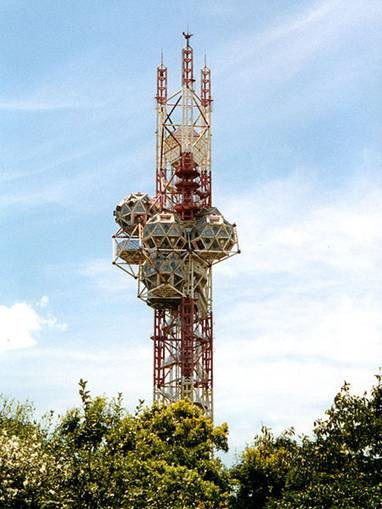
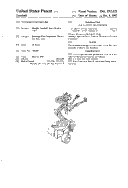

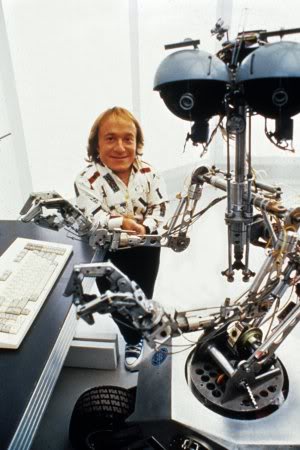
Thanks for this. I also watched the movie as a child, and enjoied watching it again 30 years later. It has its plot holes (Come on – his job is to be a caretaker for the trees, and yet he does not know they need light? And why exactly is it necessary to nuke the trees, instead of simply abandoning them?), but maybe one should not take this too seriously, and see it as a piece of art that wants to transport a message. I always wondered how they did animate the drones…
Came across this site whilst looking for pics of the drones. I love the film and the sound track was/is awesome. I'm going to try and make my own drone. It would be nice to see a reunion of all the cast and crew and for those that cannot attend (RIP Mark Persons) maybe their grand daughters could attend and remember their stories? Unfortunately I'm in the UK so I may not get to attend if there is one. Thanks for the write-up. This movie is up there with the greats.
I was SHOCKED when I found images I had cut out of the Esquire Magazine in late 1973. I had those old copies back then, including the one with Silent Running, and cut out the images of the amputees. I had seen this movie not long before this time, as it ran locally on television in the Fall of 1973. I thought I'd never see those images again! Excellent article! I revisited the movie on YouTube!
I came here after Googling the WALL E robot and remembering the drones in Silent Running, one of my favourite films. Yours is a truly entertaining and informative website giving visitors a chance to admire the work of the amputee actors, which without your site I wouldn't have known of their contribution to the film and would have carried on assuming the drones were operated remotely.
for VERSATRAN, see here http://cyberneticzoo.com/early-industrial-robots/1958-62-versatran-industrial-robot-harry-johnson-veljko-milenkovic/
So glad to see this information is available on the internet. A great addition to the photos and snippets my father shared about his involvement in the movie and the robotics. He worked for AMF Versatran Division in the 1960s and 1970s. Thank you for making this available.
Jó film volt. Különösen izgatott, hogy kik voltak a robotokban. Ezen az oldalon minden kérdésemre választ kaptam. Köszönöm.
How fabulous and inspiring to watch a movie I first fell in love with in 1972 and to watch it again 41 years later. My first viewing of Silent Running was a revelation; the second one four decades later, no less of an experience. Searching and finding this comprehensive look behind the scenes of the robotics for the movie is a spectacular follow-up. Thank you for creating it.
I was so excited to find this on the internet. Mark Persons was my grandfather. He was a wonderful man. This is a great movie. Too bad Grandpa died so young and couldn`t have made more movies.Love you forever Grandpa<3